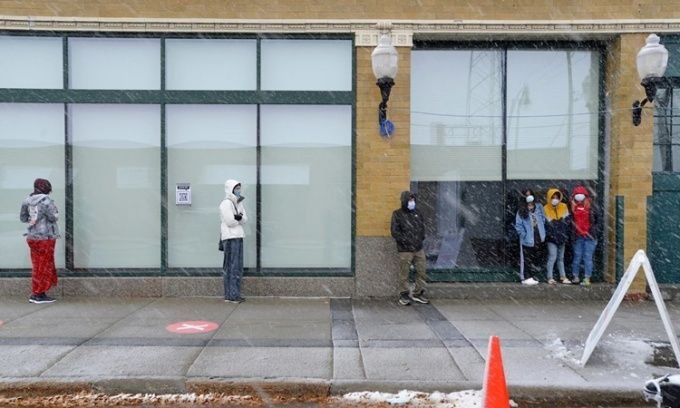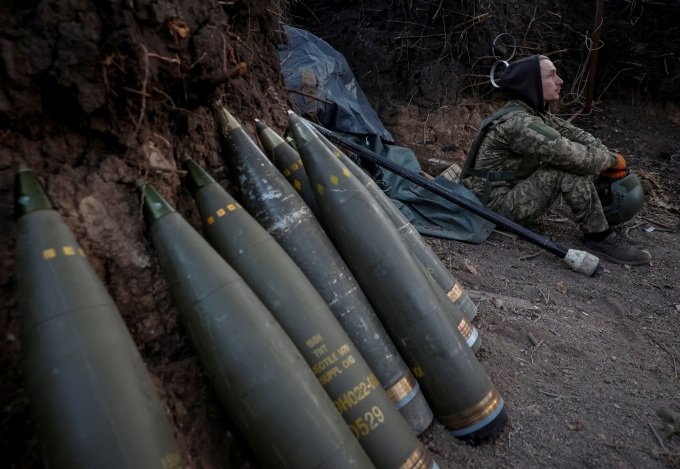
Covid-19 returns to ‘take revenge’ on America and Europe
All over the United States, where the recent presidential election attracted all the attention of public opinion, Covid-19 is rising again silently but extremely fiercely.
In North Dakota, hospital beds are so scarce that patients infected with nCoV are transported by ambulance to medical facilities more than 100 miles away.
`We used to hope that we had escaped Covid-19,` said Tim Mahoney, mayor of Fargo, North Dakota.
After suffering two waves of Covid-19 in the spring and summer, many US states rushed to reopen, while President Donald Trump urged economic recovery.
But the number of new daily infections in the US has continuously reached unprecedented highs in recent days, exceeding 150,000 cases a day for the first time since the outbreak.
People lined up waiting to be tested for nCoV on November 10 in Fargo, North Dakota.
Dr. Anthony Fauci, America’s top infectious disease expert, warned that the country will face `a very challenging and ominous situation` as winter approaches.
With more than 11 million cases, the US is the country with the highest number of nCoV infections in the world and the rate of virus spread shows no signs of slowing down.
Latest data from the Covid Tracking Project shows that the current increase in cases is not caused by increased testing.
One reason may be due to the change of season, when the weather is colder before winter, causing people to increase gatherings indoors, where the risk of infection is high because of not strict social distancing and the system.
`During the day, people comply with epidemic prevention regulations,` said Emma Stein, senior editor at Michigan Daily.
The data also shows that in the spring and summer, the number of people hospitalized with Covid-19 was roughly the same.
However, an encouraging sign is that the number of Covid-19 patients on ventilators is now fewer than in the spring and summer, suggesting that treatment methods have made certain progress.
According to a recent study in New York, experts found that the death rate of Covid-19 patients has decreased by 18 percentage points compared to the spring.
But this improvement depends entirely on the quality of patient care of the health system and it will become impossible if hospitals are overloaded and medical staff are under pressure.
Despite progress in anti-epidemic efforts, the number of daily deaths from Covid-19 in the US has once again increased.
The current Covid-19 outbreak is the third wave to hit the US this year, but the main difference is that it affects all areas at the same time, instead of concentrating in a few hot spots as before.
The spring wave of Covid-19 mainly swept through the northeastern region of the United States, while the summer wave hit hardest in the southern and western regions.
In March, the New York health system struggled to cope with a sudden increase in infections.
Doctors across the country were able to respond to the above call because at that time, the epidemic area was isolated in the northeast region.
In recent weeks, the world, especially the US, has received a lot of good news related to Covid-19 vaccines, but no matter how quickly research is done, they cannot stop the current wave of infections.
Dr. Fauci last week warned Americans to `watchfully wait` before a vaccine becomes available.
Instead, according to Fauci, people need to `more strictly` comply with epidemic prevention measures such as community isolation, wearing masks, and washing hands frequently.
A prediction model by experts at the University of Washington shows that the US could record an additional 100,000 deaths from Covid-19 from now until January 20, 2021, the time of transfer of power from the Trump administration to the government.
Europe is also witnessing a similar wave of Covid-19, as the weather gets colder in winter.
France announced a second blockade from October 30 after the number of daily deaths related to Covid-19 increased to the highest level since April. However, the effectiveness of this measure is still quite limited.
People are only allowed to leave home for urgent work or health reasons.
All forms of non-essential travel are banned and borders are closed.
Austria began imposing a three-week nationwide blockade from November 17 to control the increase in Covid-19 infections before Christmas.
People are asked to stay at home with very few exceptions such as shopping or exercising.
Poster advising people to wear masks and social distance in Berlin, Germany.
Earlier this month, Germany also began imposing a nationwide blockade to stem the rise in Covid-19 infections, closing restaurants, bars, gyms, cinemas and banning travel.
However, the number of new infections each day continues to increase, reaching a record level of more than 23,500 cases on November 13.
Portugal is experiencing a second wave of Covid-19 that is worse than the first and it has responded to the crisis with one of Europe’s strictest lockdowns, introducing nighttime curfews and late closures.
People are encouraged to work from home even though schools, shops, and restaurants are still open.
One big difference in the second wave is that public support for the government’s handling of the pandemic is waning in many European countries, leading many to doubt the latest restrictions are dangerous.
`If many people don’t trust what they’re being asked to do, resentment will smolder and eventually explode, and people will stop following the rules,` said Robert Dingwall, professor emeritus of sociology.
Vu Hoang (According to BBC, Guardian, WSJ)


